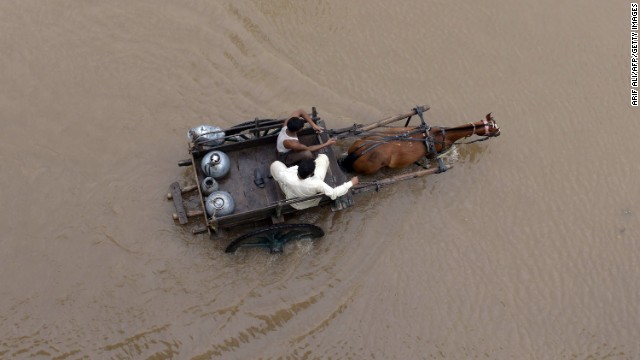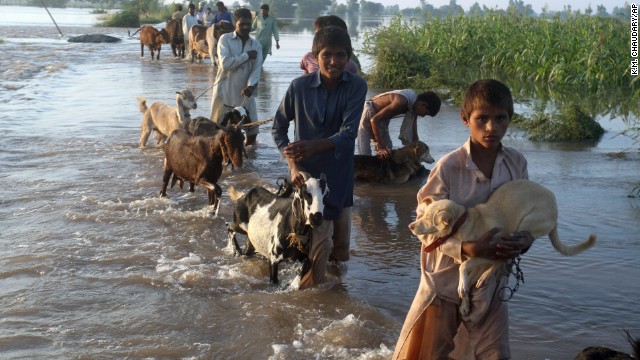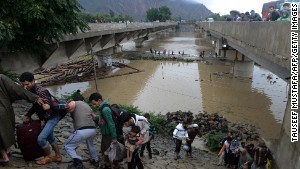Relief efforts in India and Pakistan hampered by destroyed infrastructure
 A huge relief operation is continuing across northern India and into
Pakistan in the wake of devastating floods that have killed hundreds of
people and left tens of thousands more stranded.
A huge relief operation is continuing across northern India and into
Pakistan in the wake of devastating floods that have killed hundreds of
people and left tens of thousands more stranded.
Authorities in Pakistan,
anticipating further rainfall and the passage of floodwaters to more
populous areas, have warned the worst is yet to come.
The death told has been
revised to 353, with 150 dead in India. In Pakistan, 203 have been
confirmed killed, with a further 834 injured.
The count is expected to rise over the following days as rescuers regain access to areas cut off by floodwaters.
The capital of
Indian-administered Kashmir, Srinagar, was also deluged, with residents
perched on rooftops and other high ground awaiting rescue. Many
buildings in the old part of the city have collapsed, local media
reports.
Key infrastructure, such as bridges and roads, has been destroyed, hampering the army's relief efforts.
Emergency rebuilding
 Photos: Monsoon flooding
Photos: Monsoon flooding

Flooding death toll rise in South Asia

Deadly floods hit Asia
Indian soldiers in the
heavily-flooded area rushed to erect temporary crossings in order to
reach people cut off by rapidly rising waters.
The focus of the Indian
relief effort will remain on Srinagar and areas of south Kashmir due to
number of people still stranded without food and water, Lt. Gen. D. S.
Hooda, chief of the Indian Army's Northern Command said at a press
conference.
Indian Prime Minister
Narendra Modi visited the region at the weekend and immediately declared
it a "national-level disaster." He said everything would be done to
provide aid and restore bridges and communication links washed away by
the incessant rains.
Modi who was elected earlier in the year, also offered to help Pakistanis affected by the huge floods.
'Flooding unprecedented'
"It is a matter of great
distress that the retreating monsoon rains have played havoc in many
parts of our two countries," he wrote in a letter to Pakistani Prime
Minister Nawaz Sharif, adding that "the devastation caused by the record
rains and the consequent flooding is unprecedented."
Following a period of
almost-nonexistent communication in the Jammu and Kashmir region of
northern India, 90 3G towers have been restored. By Tuesday, 23,530
stranded people had been evacuated by army units equipped with
helicopters and boats and deployed across the province.
The Indian Army has also
employed social media to monitor distress messages forward them to
rescuers. Around 7,000 such distress messages have been relayed so far
and many have resulted in the rescue of stranded residents.
"The Indian Army will
not move back to the barracks till the last man is brought to safety,"
Indian Army General Dalbir Singh said.
The four-month monsoon
season shows no signs of abating, with wet weather forecast for next
week as well. Western regions of the subcontinent have usually seen the
last of rains by early September, but the Indian Meteorological
Department forecast "heavy to very heavy rainfall" in a number of states over the next few days.
Peak yet to pass
In neighboring Pakistan,
heavy rains have continued over the past few days, causing flooding
from the main rivers of that region.
Ahmed Kemal, the
spokesperson for the National Disaster Management Authority, confirmed
the flooding is going to continue into the South of Pakistan into Sindh
due to rising water levels in barrages, making this a nationwide crisis.
"The major peak is still
to pass," he told CNN. "We have to realize that water is rising
inundation is expected and will create some sort of flooding. This
situation is only going to get worse."
The evacuation of
northern areas of the country is underway and as of Monday, Kemal said
18,227 people have been evacuated and moved to relief camps in
northwestern Punjab province.
Rainfall during this
monsoon season has been below average this year, but the heavy rain of
recent days has burst riverbanks across the northern part of both
countries.
The Jehlum and Chenab
rivers in northern Pakistan have seen water levels rise by as much as 18
feet, turning parts of their courses into de facto lakes as much 10
kilometers (six miles) wide.
As one of the most
mountainous places in the world, floodwaters from the north eventually
will make their way downstream and could cause flooding in the coastal
plains to the south, particularly along the course of the Indus river.
Some 300 million people live in the basin of the Indus river.
As many as 1,500
stranded people rescued by troops using helicopters and boats from areas
of Punjab, the country's most populous region. The Pakistani army also
airdropped 10,000 food packs to various flood-hit areas.
Army troops have also been moved to towns in the stricken region.










0 comments:
Post a Comment